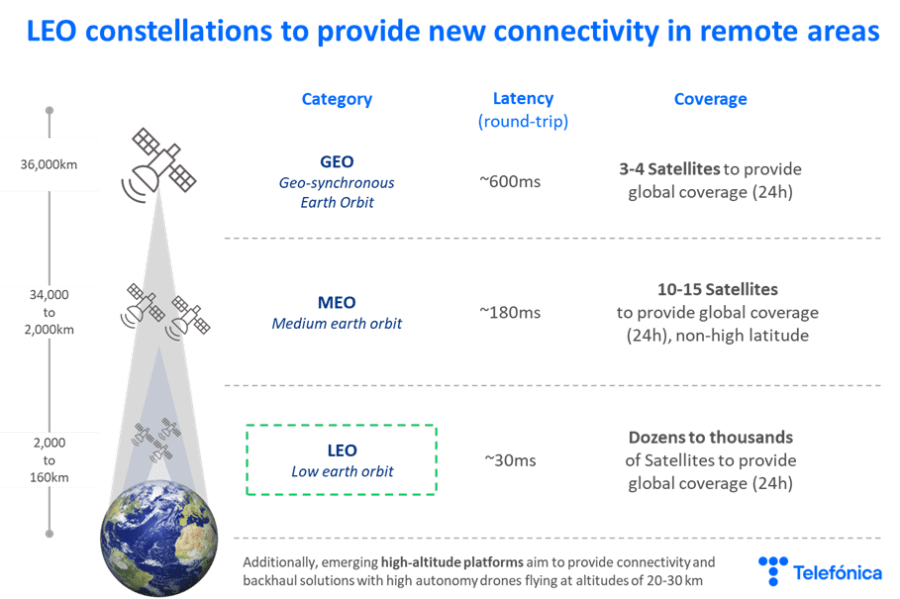Technology often surprises us. This has been the case of satellite communications in recent years. The increase in capacity and performance of the GEO stationary satellites in the last decades, providing backhaul for cellular networks or coverage to dedicated receivers in remote areas, has been followed by the emergence of Low-Earth Orbit (LEO) satellite constellations, which offer a further significant improvement, including for IoT-focused services.
Among other things, new satellite systems can also provide services to ordinary mobile devices, using the mobile spectrum (specific mobile satellite bands MSS or mobile bands), typically referred to as Direct-to-Device (D2D). This can complement the coverage of terrestrial mobile networks for all users, who in practice can have outdoor coverage everywhere, and enable new applications in aeronautical and maritime environments, or continuity of service in situations such as natural disasters.

How is a Direct-to-Device service now possible?
Until recently, it was not possible to connect a satellite directly to an ordinary mobile phone. The usage of mobile spectrum bands and improvements in technology have made this possible.
A key factor is distance. LEO satellites orbit just a few hundred kilometers above Earth, allowing communication with regular transmission power equipment. Antenna technology is also crucial: complex arrays create highly directional beams, boosting signal strength and enabling frequency reuse in the ground. Beamforming allows for fixed cells on the ground, often less than 100 kilometers in diameter – small compared to the satellite’s orbit, but still larger than terrestrial network cells.
While GEO-based Direct-to-Device services are feasible, LEO constellations are better suited for a broader range of these services with higher performance. A key factor enabling the growth of medium- and large-scale constellations has been the evolution of the satellite launch market, making space access easier. Continued advances, like larger reusable rockets and more launch providers, will further accelerate this impact.

Are Direct-to-Device services a substitute for traditional mobile services?
It’s great for very low to maybe medium-sparsity situations, but it’s not good for high-density situations
For mobile users, the assurance of outdoor coverage everywhere—even in remote areas—makes satellite networks a valuable complement to terrestrial networks. However, limitations in Direct-to-Device satellite services, like latency, performance, and capacity, mean that satellites won’t easily replace terrestrial networks, even in less dense areas. These satellite networks lack scalability, and co-existence with terrestrial networks can also limit their use, depending on the frequencies, target services, and regions. Some limitations:
- Indoor Coverage: Connecting indoors will generally be difficult due to high building penetration losses.
- Capacity: Capacity will be limited, given the (still) large satellite beam footprints and achievable bandwidth allocations per beam, with complexity and cost limitations coming from the satellite design. The satellites will therefore be able to provide simultaneous services to a reduced number of subscribers within the large satellite cells, with more constraints for higher-rate services. The capacity of terrestrial mobile networks will always be several orders of magnitude greater than that of satellites, making the extension of mobile services to remote areas the main case for Direct-to-Device satellite systems.
- Performance: Throughput is lower and latency higher than in terrestrial networks. While adequate for some applications, satellite performance may not meet specific demands.

What are the key challenges of Direct-to-Device satellite services?
The key challenges for satellite mobile D2D services include:
- Technological complexity: The first challenge is a very interesting one for an engineer: technology, as these systems have a high technological complexity and require several enhancements with the latest technology. Among these, I would highlight the satellite antenna technology. The need for high antenna gain (to improve coverage and performance) and directivity (to allow greater re-use of frequencies and thus higher capacity), as well as the need to generate a large number of simultaneously active beams within the satellite’s large field of view (the overall diameter can be up to a few thousands kilometers), necessitates of very large antenna arrays. These arrays, often tens of metres in size, contain many hundreds of active elements in the antenna. This calls for quite innovative techniques, especially for systems targeting services other than just basic services, and a reasonable capacity per satellite and cell.
- Investment: To cover the whole world with low orbit satellites with reasonable capacity, the number of satellites in the constellation must be high. We are talking about hundreds to thousands of satellites that have to be renewed quite often (the useful life of a satellite can be as short as 5 years, depending on the selected orbits and the design). The investment needs that the business case has to support are quite relevant. This level of investment will only be affordable for a quite reduced number of players.
- Limited market competition: The high costs and first mover advantage mean that only a small number of sustainable constellations can emerge (an oligopoly). This limited competition leads to increased reliance on a small number of providers, geopolitical and resilience concerns, and market dominance that could result in unfair terms or high service costs, which could also hinder adoption in some markets.
- Regulatory challenges: Mobile and satellite operators providing end-to-end communications services face complex regulatory requirements across countries, such as access to emergency services and device location, parental control, data privacy, consumer protection, lawful interception, or avoidance of unintentional roaming, which are standard features in terrestrial networks. Cooperation and partnership between satellite providers and mobile operators is key to address the regulatory and market challenges and for supplementing satellite coverage of terrestrial networks.
- Spectrum policy: Effective spectrum management is essential to open up opportunities for satellite connectivity without creating disruption or spectrum scarcity for existing terrestrial services. Terrestrial networks, which provide value to millions of users, should be protected from interference. When using spectrum licensed to a mobile operator, satellite operators should have an agreement with the terrestrial licensee that includes mitigation measures to protect its customers. Regulatory measures (such as power thresholds) are in addition required to avoid interference with other operators (e.g. due to satellite uplink interfering the terrestrial signal), both within the same country and across borders, especially in regions like Europe where national boundaries are close. Spectrum scarcity poses another challenge: as demand for spectrum grows, it would be inefficient to reserve terrestrial spectrum exclusively for satellite use, especially in dense urban areas. Spectrum sharing between satellite and terrestrial networks is emerging as a solution, but it requires advancements in interference management and rigorous testing of technical mechanisms to enable effective sharing in both urban and remote areas.
Overall, although challenging, satellite-based mobile communications offer the promise of ubiquitous outdoor coverage, but only as a complement to terrestrial networks. Cooperation between agents is required for multi-layered architectures and rules need to be evaluated to ensure efficiency and also fair competition with terrestrial networks.










